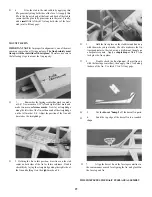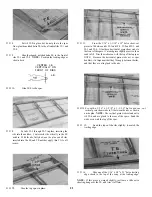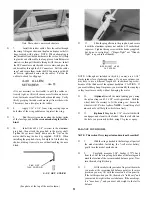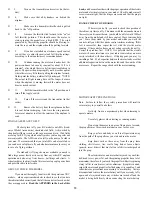
D 3. Attach the nylon clevises to the nylon aileron
horns.
D 4. With the ailerons and the servo in the neutral
position, mark the pushrod wires where they cross the holes
in the servo arm.
D 5. Using a pliers, make a "Z"-bend in each of the
pushrod wires at the marks you just made, and cut off the
excess wire.
D 10. Insert the wires into the holes and slots in the
1/4" x 1/4" balsa stick and glue them in place with thin
CA.
D 6. Work the pushrod wires into the holes in the servo
arm. NOTE: You may ha veto drill the servo arm holes with
a 5/64" drill bit. to fit the wires.
D 11. Use your T-bar to sand the ends of the balsa
pushrod to a rounded and somewhat pointed shape, as shown
on the plans and in the photos. This will reduce the chance
of the pushrod binding against something inside the fuse-
lage.
PREDICT THE FINISHED FLYING WEIGHT
D 12. Wrap the ends of the pushrod with strong thread,
as shown on the plan, apply thick CA to the threads and
smooth it out with a piece of waxed paper. Allow to harden.
MAKE THE AILERON PUSHRODS
D 1. Screw the nylon clevises onto both of the remain-
ing pushrod wires that are threaded on one end. Screw them
on all the way until the threads are protruding inside the
clevis.
D 2. Make the single bend in each pushrod as shown on
the wing plan.
At this time you should try to accurately predict
what the final weight of your ElectroStreak will be. You are
shooting for a target weight of 40.5 ounces without landing
gear, or 42 ounces with landing gear, and using a 7-cell 1200
mAh motor battery. If it looks like your airplane will be only
1 ounce overweight, don't worry about it, as the flight per-
formance will still be satisfactory. If, however, you predict
a final weight that will be 2 or 3 ounces overweight, you
should consider one or more of the following:
1. Give the entire airframe another good sanding.
Round the fuselage comers more, etc. Drill some 1/4" light-
ening holes in the landing gear plate and landing gear
doubler areas. You may be able to cut 1/2 oz. off the weight
by doing this.
2. Consider operating the plane without the land-
ing gear... a weight savings of 1-1/4 oz.
3. Consider covering the airplane with a very
lightweight covering film, such as "Black Baron Film" or
"Micafilm", and stay with a very simple trim scheme to
avoid excess weight.
4. Consider using a 7-cell 800 mAh motor battery,
which will provide good power and a weight savings of ap-
proximately 5 ounces; but will result in shorter flight times.
28













































